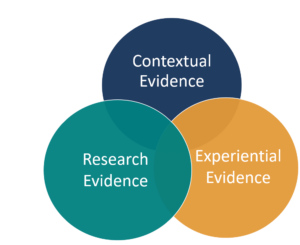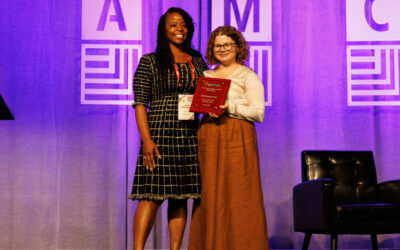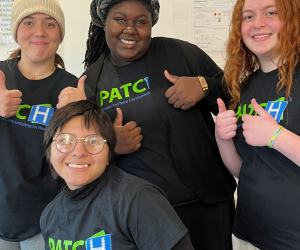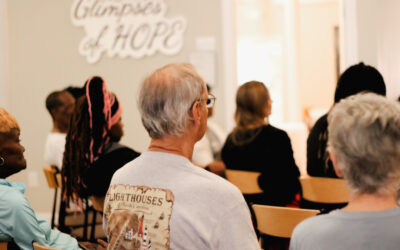
AMCHP Innovation Hub is an online platform that provides maternal and child health (MCH) professionals and advocates with resources and tools to explore, build, and share effective work grounded in evidence that contributes to improving the health and well-being of MCH populations and their communities. It is home to the MCH Innovations Database, a searchable repository of “what’s working” in the maternal and child health field (also known as practice-based evidence) that includes both practices and policies. Learn more about Innovation Hub’s resources and support by exploring the tabs below.
Learn More
How AMCHP Thinks About Evidence
In the MCH field there is a growing emphasis on the importance of using evidence-based practices to address MCH challenges, but what do we mean when we say “evidence”? How we define “evidence” has implications for what we consider evidence and has the power to further invalidate, stigmatize, and oppress the experiences of those from historically under-resourced communities. There is also a tendency to assign more value to evidence generated by experimental studies and evaluation designs (Best Available Research Evidence) than other types of evidence. While evidence from scientific research studies is important, so are other types of evidence. AMCHP recognizes many forms of evidence as valid ways of demonstrating a practice or policy is effective and defines “evidence” as:
Anything that demonstrates a given activity has an intended impact for a specific community or population. Recognizing that public health occurs in “real world” settings, what we consider evidence should not be limited to that which comes from controlled scientific research; it should also include and uplift evidence that is defined by impacted communities and represents the values, needs, and preferences of those with lived experience.
This definition is intentionally broad to capture the full breadth of information and practice-based insights that can demonstrate the effectiveness of programs and policies. These include the best available research evidence, experiential evidence, and contextual evidence:

| Best Available Research Evidence | Information resulting from systematic and methodical ways of gathering data using various study methods and ongoing evaluations. It includes evidence from systematic reviews, experimental (e.g., randomized control trials), quasi-experimental (e.g., longitudinal), and non-experimental (e.g., pre-/post-test) study designs (Puddy & Wilkins, 2011). |
| Professionals’ Experiential Evidence | Insights from professionals that are accumulated over time and is often referred to as intuitive or tacit knowledge (Puddy & Wilkins, 2011). |
| Individuals’ Experiential Evidence |
Insights gained from individuals with the lived experience of being impacted by a program or policy (or lack thereof) sharing their values, needs, preferences, and expertise. A subset of this type of evidence is known as community-defined evidence (CDE) which is a “set of practices that communities have used and found to yield positive results as determined by community consensus over time and which may or may not have been measured empirically but have reached a level of acceptance by the community”. CDE emphasizes the inherent knowledge, experience, and expertise in communities defining what “works for them”. (Martinez et al., 2010). |
Our Partners
AMCHP collaborates with a variety of partners to build and strengthen the MCH evidence-base and to support MCH professionals and advocates to integrate more evidence-based initiatives into their work.
We collaborate with the Strengthen the Evidence Base for MCH Programs Initiative at Georgetown and the National MCH Workforce Development Center at UNC to provide evidence and implementation-related technical assistance to MCH professionals. Learn more about AMCHP’s partnership with these groups here.
AMCHP also partners with the Prenatal-to-3 Policy Impact Center at the University of Texas at Austin LBJ School of Public Affairs on our Evidence-Informed Policy Track of the Model Innovations Database. Check out their work to learn more about the best public investments into state policy actions that produce results for young children and society.
 |
 |
 |
Innovation Hub 101- Video series
Watch the short videos below to learn more about the various components of AMCHP’s Innovation Hub!
MCH Innovations Database
AMCHP’s Evidence-Based Practice Initiative began in 2010 with the establishment of AMCHP’s Innovation Station Database, now called the MCH Innovations Database. This database was developed to serve as a repository of effective MCH practices that Title V professionals could look to for inspiration and could replicate or adapt to their own context. Over time, this resource has evolved to serve the entire MCH community, beyond Title V. More than just a database, AMCHP’s Innovation Hub has grown to be a comprehensive online platform of resources to help MCH professionals identify, implement, share, and replicate practices and policies grounded in evidence.
The MCH Innovations Database is a searchable repository of “what’s working” in the field that improves the health and well-being of MCH populations. It features both practices and policies happening across the country that positively benefit women, children, families, and communities. Practices in the database are assessed along a continuum and receive a designation of Cutting-Edge, Emerging, Promising, or Best depending on their work’s demonstrated impact, among other criteria. Policies in the database are assessed according to whether or not they meet the criteria to be considered a model example of Evidence-Informed Policy Development, Policy Implementation, or Policy Evaluation.
Opportunities to Support Your Work
Replication Projects
Each year, AMCHP awards up to four organizations to replicate a practice from the MCH Innovations Database. Based on their readiness to begin replication, awardees will receive peer coaching and guidance from a representative of the practice as well as tailored assistance from AMCHP to help adapt the practice to their unique context and situation. To learn more about the process and our current awardees, visit our Replication Projects page.
Innovation Hub Learning Community (IHLC)
The Innovation Hub Learning Community (IHLC) offers programmatic support to all practices in the MCH Innovations Database through one-on-one tailored coaching, didactic webinars, and peer sharing opportunities. The IHLC aims to:
- Provide a responsive and proactive network of programmatic support for all participants
- Facilitate spaces for peer-sharing in which participants can co-create solutions and share programmatic successes and challenges;
- Offer learning opportunities that boost participant confidence applying evaluation and implementation principles and tools; and
- Encourage and support Innovation Hub practices to resubmit their work to the MCH Innovations Database and move up the Practice Continuum.
In 2024, AMCHP hosted four webinars on topics related to programmatic best practices that all MCH professionals and advocates are welcome to attend. Explore below for recordings of each webinar:
- March 2024: Who’s at Your Table? Power Sharing and Asset Framing
- May 2024: Stop Building the Plane as We Fly It: Being Intentional w/ Strategic Planning
- September 2024: “Say More About That”: Qualitative Reseach and Interviewing Considerations
- November 2024: Cultivating Community Solutions: Building Capacity for Community-Rooted Evidence in Title V Funding Practice
Submission Support
AMCHP’s Evidence & Implementation team is happy to offer support to those interested in submitting to the MCH Innovations Database. This support can include having a call to identify which designation a practice or policy should submit to, helping you scope the information you should include in your submission, as well as helping individuals to complete submissions over the phone. We are happy to assist you with your submission! Email us at evidence@amchp.org to schedule.
General Support
Our team also offers tailored support to increase the capacity of states and jurisdictions to optimize the use of evidence to shape and champion effective policies and programs. Email us at evidence@amchp.org to learn more about the type of assistance that we can offer.
Examples of support that AMCHP provides:
- A state/jurisdiction has previously received help its ESMs, and now wants examples of programs that others have used to achieve similar outcomes.
- A state/jurisdiction or MCHB-funded project (like a CoIIN) would like to submit an effective practice or policy to Innovation Hub.
- A state/jurisdiction would like to replicate a practice or component of a practice from Innovation Hub.
- A state/jurisdiction has a question about where to find assistance related to the implementation of a strategy that advances their state action plan.
Submitting a Practice or Policy
Do you have a practice or policy that is positively benefiting women, children, families, and communities? Share it with AMCHP’s Innovation Hub! Practices in the database are assessed along a continuum and receive a designation of Cutting-Edge, Emerging, Promising, or Best depending on their work’s demonstrated impact, among other criteria. Policies in the database are assessed according to whether or not they meet the criteria to be considered a model example of Evidence-Informed Policy Development, Policy Implementation, or Policy Evaluation.
Click on one of the buttons below to learn more about how to share your work to the MCH Innovations Database.
Get Involved with Innovation Hub
MCH Innovations Committee
AMCHP Innovation Hub is supported by the MCH Innovations Committee. The purpose of the MCH Innovations Committee is to assist AMCHP to identify, review, amplify, support, and encourage the replication of innovative and effective maternal and child health (MCH) practices and policies. Responsibilities of the committee include:
- Serve as a reviewer for Innovation Hub’s biannual review of practices and policies, at least once per committee year.
- Work with AMCHP staff to provide feedback on, support the development of, and ensure the accessibility and appropriateness for MCH audiences of, AMCHP Innovation Hub technical assistance opportunities, trainings, and resources on an as needed basis.
- Identify and refer effective practices and evidence-informed policies to the MCH Innovations Database.
- Work with AMCHP staff to foster collaboration with community-rooted organizations to support them to submit their work to Innovation Hub.
- Serve as an Innovation Hub ambassador by speaking about, promoting, and disseminating Innovation Hub-related opportunities and resources.
- Support practices/policies accepted to the MCH Innovations Database to further develop their work and respond to reviewer recommendations, depending on Committee member bandwidth and availability.
- Identify opportunities to align with and support other AMCHP initiatives and organizational committees.
- Identify opportunities to align with and support MCH partners and other TA providers with a similar focus/mission as the committee, including but not limited to the National MCH Workforce Development Center and the MCH Evidence Center.
Please email evidence@amchp.org and/or complete the AMCHP Committee Form if you are interested in joining the MCH Innovations Committee.
Review for Innovation Hub
Innovation Hub submissions are reviewed by a team of three volunteer reviewers who are matched with a submission based on their MCH areas of expertise. Reviewers assess the submission according to criteria related to the designation the submission applied for. Reviewers provide applicants with direct feedback on each submission’s strengths as well as areas for growth and improvement.
Time Commitment
Each review runs for approximately two months, once in the Spring and once in the Fall. The time commitment for serving as a reviewer is roughly 3 hours total including watching an orientation video, reviewing your assigned practice and filling out the scoring form, participating in one 45 min review call with your fellow reviewers, and and completing a survey on your experience.
Reviewer Benefits
Benefits of serving as a reviewer include:
- Contribute to the MCH field by providing valuable feedback to developing and established practices and policies
- Be on the forefront of emerging MCH evidence-based/-informed practices and policies
- Gain experience with program evaluation and a peer-review process
- Develop professionally while learning how AMCHP defines evidence and evaluates practices
- Connect with MCH professionals from around the country
Sign Up to Be a Reviewer
Interested in reviewing practices? Complete this short sign up form, and our team will contact you with next steps
This project is supported by the Health Resources and Services Administration (HRSA) of the U.S. Department of Health and Human Services (HHS) under grant number U01MC00001 Partnership for State Title V MCH Leadership Community Cooperative Agreement ($1,696,335). This information or content and conclusions are those of the author and should not be construed as the official position or policy of, nor should any endorsements be inferred by HRSA, HHS or the U.S. Government.
Representing BirthMatters at the 2024 AMCHP Annual Conference: Feeling the Pride of Partnership with AMCHP
By Amber Pendergraph-Leak, CD(DONA), CLC, CHW, CMA, Executive Director, BirthMatters, and recipient of this year’s Innovation Hub Partnership Award About BirthMatters Hello! I am Amber Pendergraph-Leak, the Executive Director of BirthMatters, a South Carolina...
Denver Health Pediatrics at Denver Public Schools Uses the PATCH (Providers and Teens Communicating for Health) Program to Improve Adolescent Health Care
By Tara Melinkovich, MPH, Youth Engagement Program Manager, Denver Health Pediatrics at Denver Public Schools Introduction Adolescence is a time of major change. Teens often feel awkward as they navigate the physical and emotional changes occurring between...
The HOPE (Honor Opportunity Purpose Excellence) Alternative Learning Program: A Replication Success Story
Enhancing Mental Health Support in Schools Lauren’s Journey: A Teacher’s Transformation Lauren was a teacher in her mid-forties working in an alternative school in North Carolina. Her commitment to her students—especially those with complex mental health needs—was...











